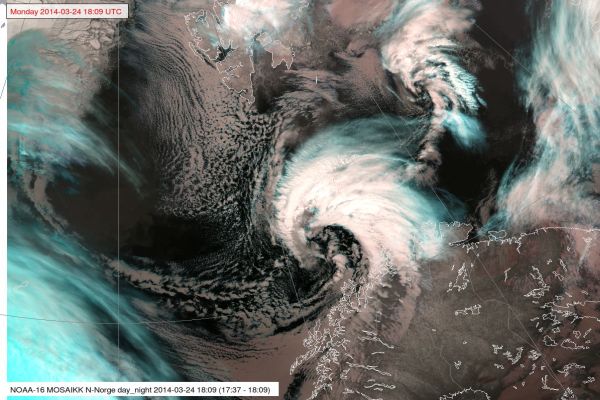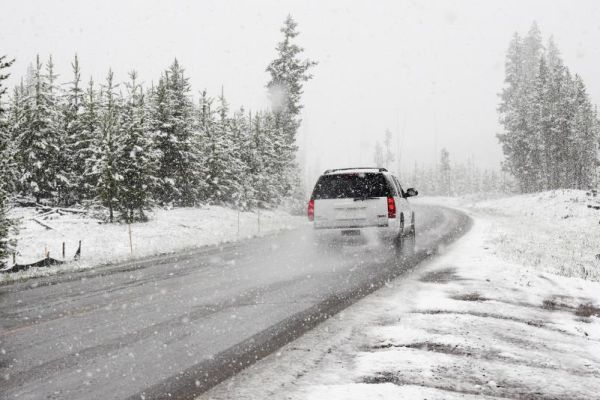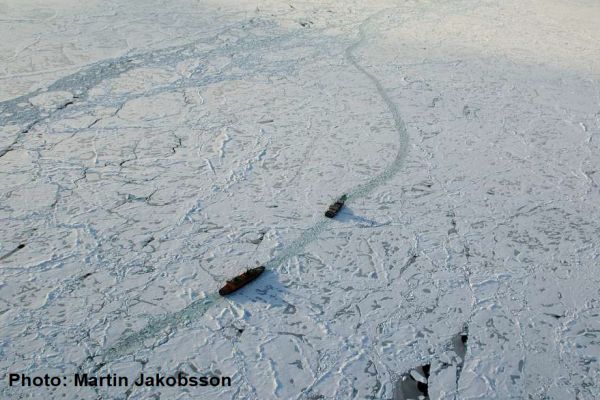High-latitude event week 2023

In the week from 30 January to 2 February 2023 EUMeTrain held a high-latitude event week. During the event week there were many presentations about winter challenges, about satellite imagery challenges, sea ice and snow. There were in total 17 presentations.

Session 1 - 30 January 2023
Gunnar Noer (MetNo): Polar Lows - Arctic Hurricane
Polar lows are small but fairly intense low pressure systems that form in the Arctic marine regions during the winter season. They form in unstable air masses associated with cold air outbreaks from the Arctic ice cap. Polar Lows give rise to gale or storm force winds which, in combination with heavy snowfall, cause widespread traffic disruptions. In recent years, polar lows have caused several fatal incidents with snow avalanches. This lecture focuses on the key processes and the methodology for forecasting polar lows.
Marjo Hippi (FMI): Predicting Sidewalk Slipperiness
Icy and snowy sidewalks are very typical phenomena in Finland during winter. Near zero temperatures and slipperiness due to ice and snow on sidewalks increases the pedestrians' slip risk. Almost every second person slips annually in Finland and around 50 000 persons (1 % of Finnish population) are injured needing medical attention. Slip injuries cause huge economic losses, long sick leaves, and human suffering. The Finnish Meteorological Institute (FMI) has developed a numerical weather model that predicts the sidewalk slipperiness from pedestrians' point of view. The model classifies the sidewalk slipperiness into three classes: normal, slippery, and very slippery. Very slippery sidewalk condition mean that the slip risk is increased. Typical situations for very difficult sidewalk situations are packed snow, freezing or ice layer covered by water or snow. The model is a tool for duty meteorologists when issuing warning about slippery sidewalk condition.
Becky Hemingway (ECMWF): ECMWF Products For Forecasting Extreme Precipitation
ECMWF produces a vast array of global forecast data on a daily basis. In order to make this data useable a large number of products are created and made available to ECMWF Member and Cooperating States and the wider meteorological community via OpenCharts and ecCharts. This presentation will focus on two products which help forecasters in forecasting extreme precipitation, Precipitation Type and the Extreme Forecast Index (EFI). Both products are generally well liked by forecasters and are seen to verify well. The talk will detail how the products are created using the ECMWF Ensemble Forecast System, discuss how to use the products and provide case studies of cold weather events including from the high-latitude regions.
Minna Haikonen (FMI): Pre-Warning Service For Railway Maintenance
Finnish Meteorological Institute produces weather services for land traffic and shipping to ensure safety and cost effective planning on everyday decision making for customers and stakeholders. FMI produces wide range of weather services including weather and road weather forecasts, observation services and warnings that can be tailored according to customer needs. One example of these a tailored weather services is a so called pre warning service for rail traffic operation and maintenance which is based on meteorological consultation via email or video conference system all around the year. FMI`s meteorologists monitor weather 24/7 basis and issue pre warnings according to the customer needs. There are several parameters that need to be monitored and the pre warning is issued whenever it seems likely that a predefined threshold will be met. During wintertime these pre warnings are proven to be very important especially before heavy snowfall cases not to mention if there is also low temperatures and hard winds appearing at the same time.

Session 2 - 31 January 2023
Virve Karsisto (FMI): FMI’s Road Weather Model And Shadowing Algorithm
Finnish Meteorological Institute’s (FMI) road weather model has been in operational use over 20 years. The forecasts help in the road maintenance decision making and give useful information for road users about the driving conditions. Recently, a shadowing algorithm has been implemented to the model to take in to account the shadowing caused by the surrounding objects. This helps to make more localized forecasts, as shadowing can cause great differences in road temperature even between different lanes.
Reima Eresmaa (FMI): The Use Of Satellite Data In Limited-Area NWP Models Of MetCoOP
MetCoOp is a group devoted to developing and operating rapidly-updating kilometric-scale Numerical Weather Prediction (NWP) systems to support meteorological applications in Finland, Scandinavia and Baltic countries. There are currently two operational NWP systems: The MetCoOp Ensemble Prediction System (MEPS) and the MetCoOp Nowcasting System (MNWC). Forecasts are provided in a limited-area grid in 2.5 km horizontal resolution and on 65 levels.
MetCoOp NWP systems assimilate a variety of satellite-based data provided by polar orbiters of NOAA, EUMETSAT, and CMA. In particular, extensive use is made of radiance measurements in microwave and infrared wavelengths. Via three-dimensional variational data assimilation, such observations help constrain the NWP model state at the initial time of each forecast. The radiance observations provide information on temperature and humidity at different altitudes.
Vesa Nietosvaara (EUMETSAT): MTG And EPS-SG – New Generation Satellites
The first Meteosat Third Generation (MTG-I) satellite with Flexible Combined Instrument (FCI) was launched at the end of 2022. It will be followed later in 2024 by MTG-S Satellite with Infrared Sounder onboard. MTG will carry novelty instruments – Infrared Sounder, Lightning Imager and Ultraviolet Visible Near-infrared (UVN) Spectrometer - in the GEO orbit. Meteosat Third Generation aims to secure continuity and to increase the capabilities of the Meteosat satellites in response to requirements of the future forecast/nowcast systems. Altogether, the new and enhanced capabilities will allow us to make a huge step in better monitoring of our environment, and allowing development of new applications.
Vojtěch Bližňák – Impact Of Satellite-Derived Cloud Cover On Road Weather Forecast In The Czech Republic
The goal of the contribution is to assess an impact of extrapolated cloud cover derived from satellite observations on forecasts of road surface temperature (RST) performed by the road weather model (RWM) FORTE. Based on road weather station measurements and forecasts of the ALADIN numerical weather prediction (NWP) model, which are used as inputs to prepare initial and boundary conditions, the RWM generates a linearly continuous forecast of RST on selected Czech highways. The work will compare the evaluation of RST forecasts generated by two model runs using NWP and satellite-derived cloud cover estimation.

Session 3 - 1 February 2023
Patrick Eriksson (FMI): Operational Monitoring Of The Baltic Sea Ice And The Various EO-Data Used
The Baltic Sea, a relatively small semi-closed basin with brackish water, is one of the most heavily trafficked sea areas in the world. Thousands of vessels visit ice-infested ports every winter, which requires well organized icebreaking. To support this winter navigation operation, the Ice Service at FMI conducts monitoring and forecasting of the sea ice throughout the winter. An essential source of information is obviously satellite data. Imagery from several satellite platforms is not only processed to serve ice charting and reporting, but is also delivered in near-real-time straight to the bridges of the icebreakers. The dark and cloudy Nordic winter has proven the Synthetic Aperture Radar instruments (SAR) to be the most suitable when analysing the development of the sea ice. Different passive instruments are also used, light and cloudiness permitting. All satellite platforms bring their various strengths and limitations on the ice analyst’s desktop, causing constantly changing challenges to the charting of sea-ice features. So far, the analysis has been predominantly manual work, but the ever-increasing data volumes are setting a demand for AI-based automatic interpretation.
Jari Haapala (FMI): Arctic Sea Ice Changes - From Quiet To A More Dynamic Regime
The mass balance of the Arctic Sea ice depends on thermodynamical and dynamic factors. Thermodynamical and mechanical sea ice state variables are strongly coupled, but the strength of coupling varies in daily, seasonal, and climate time scales. When the ice pack is thick, solid, and compact, this coupling is strong and large areas of pack ice are mechanically connected. In these circumstances, the internal stress of pack ice accumulates and reduces differences in ice motion. In these conditions drift speed of the Arctic Sea decreases, the age of ice increases and the total mass of the ice pack increases. On the contrary, a thinner ice pack which includes cracks, leads, or larger open water areas is in turn mechanically weakly connected, exhibits larger variations in motions in shorter time and length scales drifts with higher speed, and exhibits shorter residence time in the Arctic. In this talk, the importance of ice dynamics on sea ice mass balance is reviewed and new findings based on the MOSAiC campaign are discussed.
Robert Hausen (DWD): MOSAIC
The presentation is about the Multidisciplinary drifting Observatory for the Study of Arctic Climate (MOSAiC) from a forecaster’s perspective. As kind of an experience report this talk gives some impressions from the preparation before the expedition started up to the uncertain outcome of Leg 3 of 6 due to the Corona Crisis and other circumstances.
Signe Aaboe (MetNo): OSI SAF Over 25 Years With A Focuse On Satellite Monitoring Of Sea Ice In North And South
Ocean and Sea Ice Satellite Application Facility (OSI SAF) was initialised in 1997 and is one of eight EUMETSAT Satellite Application Facilities, which provide users with operational data and software products from meteorological satellites.
The OSI SAF programme has a focus on the ocean-atmosphere interface and derives ocean products of wind, temperature, radiative fluxes and several perspectives of the sea ice. This presentation will give an introduction to OSI SAF, - what it is, who is involved, and which products are derived. The main focus will be on sea-ice developments and products.
Kerttu Kouki (FMI): Decadal Changes In Arctic Snow And Ice Cover Properties From Satellite Observations
Snow and ice cover of the Northern Hemisphere (NH) are major factors in the global climate system.
Due to the large area and sparse in situ measurements, snow and ice cover monitoring at the continental scale is only possible from satellites. Estimating snow and ice cover at large scale is important for hydrological and climatological applications. As they greatly influence the entire climate system, changes in snow and ice cover will affect the surface energy balance, which in turn makes snow and ice cover important inputs for climate models.
Snow and ice cover in the Arctic are changing. There is a negative trend in the surface albedo due to negative trends in snow and ice cover. The extent and duration of snow and ice cover are decreasing, and the changes are most prominent in spring due to the strong surface albedo feedback. Snow water equivalent (SWE) also shows negative trends globally, but significant spatial variability exists especially in the Arctic.

Session 4 - 2 February 2023
Johannes Häkkinen (FMI): Precipitation Type And Satellite Images For High Latitudes
The presentation will go through different precipitation types, forecasting the precipitation types, and supporting the weather model with satellite images. The precipitation types are estimated from a model sounding by top-down method. Satellite imagery is mainly used for estimation of the cloud top. The focus is on aviation weather and short-term forecasts.
Pia Isolahtenmaki, Robert Makitie (FMI): Dense Fog From An FCI View
On the 11th of September an almost stationary frontal system occurred over southern Finland leading to development of a large fog cloud over the Gulf of Finland and the Baltic Sea. The fog later moved slowly over southern Finland, where Finland’s busiest airport, Helsinki-Vantaa airport, is located. The fog cloud that occurred over the Gulf of Finland was hard to spot from SEVIRI images due to different layers of middle and high clouds. When thinking about the future, the question arises, would the FCI have spotted something more in this situation?
Juuso Paajanen (FMI): Challenges In The Nordic Airports, Replacing Satellite Observations With Other Observations And Models
Parallax shift, Limb cooling, Low sun elevation angle are some of the issues associated with mainly geostationary satellites in the high-latitudes. Some satellite images are shown to demonstrate these issues. Some solutions are suggested here for countering these problems.
This presentation talks about Example of the tools we are using in our operational work.
Ine-Therese Pedersen (MetNo): Icing In The Arctic – Cases From Svalbard
Weather forecasting in the Arctic is challenging, and the further north you go, the more difficult it can be to meet this challenge. Svalbard is situated between 74-80 degrees north and consists of several islands with high mountains, deep fjords, and large glaciers. The terrain makes it even harder to model and forecast the weather. In addition to cold, snowy weather in wintertime, one of the large challenges is icing in autumn and winter. This has an impact on both roads, animal living conditions, and air traffic. This talk will go deeper into icing in relation to air traffic on Svalbard, mostly connected to the main airport, Svalbard Airport, situated near Longyearbyen."
